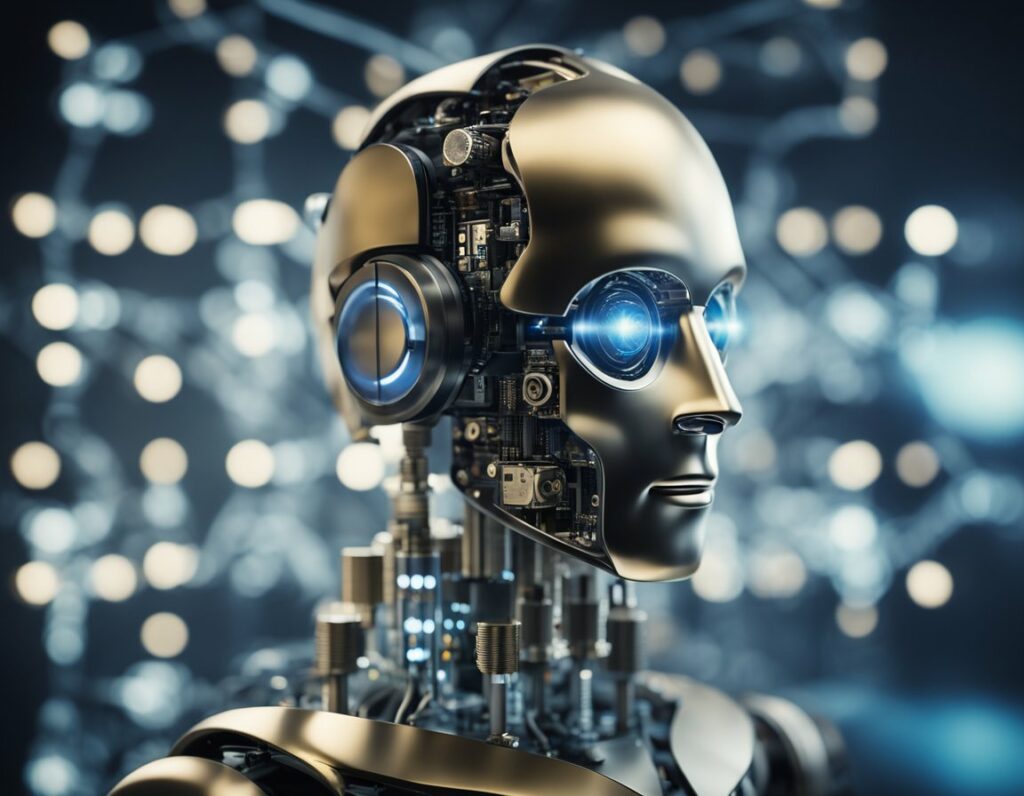Artificial Intelligence (AI) has become a buzzword in recent years, but its development can be traced back to the mid-20th century. The father of AI, Alan Turing, laid the foundation for modern AI with his work on the Turing Test in the 1950s. Since then, the field of AI has rapidly evolved, and its impact can be seen in various sectors, from healthcare to finance.

In the early days of AI, researchers focused on creating rule-based systems that could mimic human intelligence. These systems were limited in their capabilities and required extensive programming. However, with the advent of machine learning in the 1980s, AI systems became more sophisticated. Machine learning allowed computers to learn from data and improve their performance over time, leading to the development of neural networks and deep learning algorithms. These AI systems can now perform tasks that were once thought to be exclusive to humans, such as image and speech recognition.
Alan Turing and the Birth of AI
Alan Turing is widely considered to be the father of modern computing and artificial intelligence. In 1950, he published a paper titled “Computing Machinery and Intelligence,” in which he proposed the “Turing Test” as a way to measure a machine’s ability to exhibit intelligent behavior equivalent to, or indistinguishable from, that of a human.
Turing’s work laid the foundation for the development of AI, and his ideas continue to shape the field to this day. He believed that machines could be programmed to think, learn, and reason, and that they could eventually surpass human intelligence.
One of Turing’s most significant contributions to AI was his work on the “Universal Turing Machine,” which is considered to be the theoretical basis for all modern computers. This machine could perform any computation that could be carried out by a human, and it was the first step towards developing machines that could perform tasks that were once thought to be the exclusive domain of human beings.
Turing’s work on AI was groundbreaking, but unfortunately, his life was cut short. He was forced to undergo chemical castration, and he died two years later, at the age of 41. Despite the tragic end to his life, Turing’s legacy lives on, and his contributions to AI continue to inspire researchers and scientists around the world.
AI in the 1950s to 1970s: Early Development and Hopes

During the 1950s to 1970s, the field of artificial intelligence (AI) was in its early stages of development. Researchers were optimistic about the potential of AI and believed that it would revolutionize the world. However, progress was slow due to the limited computing power available at the time.
One of the most significant contributions to the development of AI during this period was the work of Alan Turing. In 1950, he proposed the Turing Test, which is still used today to determine a machine’s ability to exhibit intelligent behavior equivalent to, or indistinguishable from, that of a human.
In the late 1950s, the first AI programs were developed, including the Logic Theorist and the General Problem Solver. These programs were able to solve complex mathematical problems and demonstrate problem-solving abilities.
During the 1960s, researchers began to explore the possibility of machine learning, which involves training machines to learn from data. The perceptron, a type of artificial neural network, was developed in 1958 and was used to recognize patterns in data.
In the 1970s, the field of AI faced a setback known as the “AI winter.” Funding for AI research was cut, and progress slowed down significantly. However, researchers continued to make important contributions, such as the development of expert systems, which were designed to mimic the decision-making abilities of human experts in specific fields.
Overall, the 1950s to 1970s were a period of significant progress and hope for the development of AI. Despite facing challenges and setbacks, researchers continued to make important contributions that laid the foundation for the advancements we see today.
AI Winter: 1970s to 1980s

Reasons for the AI Winter
During the 1970s and 1980s, the field of artificial intelligence (AI) experienced a period of stagnation known as the “AI Winter.” There were several reasons for this decline in interest and funding for AI research. One of the main reasons was the failure to deliver on the promises and expectations of AI during the previous decade. Many believed that AI would soon achieve human-level intelligence, but progress was slower than anticipated.
Another reason for the AI Winter was the lack of computational power and data available to researchers. The computers of the time were not powerful enough to handle the complex algorithms and models required for AI research. Additionally, there was a lack of data available to train and test AI systems.
Impact of the AI Winter
The AI Winter had a significant impact on the field of AI. Many researchers and companies shifted their focus away from AI and towards other areas of computer science. Funding for AI research decreased, and many AI projects were canceled or put on hold.
However, the AI Winter was not all negative. It forced researchers to reevaluate their approach to AI and focus on developing more practical applications for the technology. This led to the development of expert systems, which were AI systems designed to solve specific problems in fields such as medicine and finance.
Overall, the AI Winter was a challenging period for the field of AI, but it ultimately led to a more practical and realistic approach to AI research.
AI Resurgence in the 1990s

In the 1990s, there was a resurgence of interest in artificial intelligence (AI) after a period of decline in the 1970s and 1980s. This resurgence was fueled by several factors, including the influence of Moore’s Law and the rise of machine learning.
Influence of Moore’s Law
Moore’s Law, which states that the number of transistors on a microchip doubles approximately every two years, had a significant impact on the development of AI in the 1990s. The increasing power of computers allowed researchers to develop more complex AI algorithms and models, which in turn led to significant advances in the field.
Rise of Machine Learning
Another factor that contributed to the resurgence of AI in the 1990s was the rise of machine learning. Machine learning algorithms allow computers to learn from data, rather than relying on pre-programmed rules. This approach proved to be highly effective for a wide range of applications, including image and speech recognition, natural language processing, and predictive analytics.
One of the most significant breakthroughs in machine learning during this period was the development of artificial neural networks. These networks are modeled after the structure of the human brain and can be trained to recognize patterns in data. This technology has since become a cornerstone of modern AI research and is used in a wide range of applications, from self-driving cars to facial recognition systems.
Overall, the resurgence of AI in the 1990s laid the foundation for many of the advances that we see in the field today. The influence of Moore’s Law and the rise of machine learning paved the way for more sophisticated AI models and algorithms, which have since become essential tools for a wide range of industries.
AI in the 21st Century: Mainstream Adoption

Artificial Intelligence (AI) has become increasingly mainstream in the 21st century, with widespread adoption in various fields. This section will explore the impact of AI in everyday life, as well as its applications in business and industry.
AI in Everyday Life
AI has become an integral part of everyday life, from personal assistants like Siri and Alexa to smart home devices that can adjust the temperature and lighting based on personal preferences. AI-powered virtual assistants have also become popular in the healthcare industry, helping doctors and nurses manage patient care more efficiently.
AI has also revolutionized the way people communicate and interact with each other. Social media platforms like Facebook and Twitter use AI algorithms to personalize users’ feeds and suggest content that they may be interested in. AI-powered chatbots have also become common in customer service, providing quick and efficient responses to customer inquiries.
AI in Business and Industry
AI has transformed the way businesses operate, from automating routine tasks to improving decision-making processes. In the finance industry, AI-powered trading algorithms can analyze vast amounts of data and make investment decisions in real-time. In the retail industry, AI-powered chatbots can assist customers with their purchases and provide personalized recommendations.
Manufacturing companies have also adopted AI to optimize production processes and reduce costs. AI-powered robots can perform repetitive tasks more efficiently than humans, freeing up workers to focus on more complex tasks. In the transportation industry, self-driving cars and trucks are being developed using AI technology, which could revolutionize the way people and goods are transported.
Overall, AI has become increasingly mainstream in the 21st century, with applications in various fields. While there are concerns about the impact of AI on employment and privacy, its potential benefits cannot be ignored.
Modern AI: Machine Learning and Deep Learning

Evolution of Machine Learning
Machine learning is a subfield of artificial intelligence that focuses on the development of algorithms that can learn from and make predictions on data. The evolution of machine learning can be traced back to the 1950s, when Arthur Samuel developed a program that could play checkers and improve its performance through trial and error.
In the 1980s, the concept of backpropagation was introduced, which allowed for the development of neural networks that could learn from large amounts of data. This led to the development of decision trees, random forests, and other machine learning algorithms that are widely used today.
Introduction to Deep Learning
Deep learning is a subfield of machine learning that focuses on the development of artificial neural networks that can learn from and make predictions on complex data. Deep learning has revolutionized the field of artificial intelligence, allowing for breakthroughs in image recognition, natural language processing, and other areas.
One of the key breakthroughs in deep learning was the development of convolutional neural networks (CNNs), which are particularly effective at image recognition tasks. Another breakthrough was the development of recurrent neural networks (RNNs), which are particularly effective at natural language processing tasks.
Today, deep learning is used in a wide range of applications, from self-driving cars to medical diagnosis to speech recognition. As the field continues to evolve, it is likely that deep learning will play an increasingly important role in the development of artificial intelligence.
Ethical Considerations in AI

AI and Privacy
With the increasing use of AI in various industries, concerns about privacy have also emerged. AI systems collect and analyze vast amounts of data, including personal information, which can be used to identify individuals and their behaviors. This can pose a threat to privacy, as the data can be misused or fall into the wrong hands.
To address these concerns, many countries have implemented data protection laws, such as the General Data Protection Regulation (GDPR) in the European Union. These laws require organizations to obtain explicit consent from individuals before collecting their data, and to ensure that the data is stored and processed securely.
AI and Job Displacement
Another ethical consideration in AI is the potential impact on employment. As AI systems become more advanced, they are increasingly capable of performing tasks that were previously done by humans. This can result in job displacement, particularly in industries that rely heavily on manual labor or repetitive tasks.
To mitigate this impact, some experts suggest that governments and organizations should invest in retraining programs to help workers transition to new jobs that require skills that are less likely to be automated. Additionally, some propose the idea of a universal basic income, where all citizens receive a certain amount of money regardless of their employment status, as a way to support those who are displaced by AI.
Overall, ethical considerations in AI are crucial to ensure that the technology is developed and used in a responsible and ethical manner. By addressing privacy concerns and the potential impact on employment, we can ensure that AI benefits society as a whole.
Future of AI

Predicted AI Advances
The future of AI is bright and promising. With the advancements in technology, AI is expected to play a significant role in shaping the world we live in. Here are some of the predicted AI advances in the future:
- Improved Natural Language Processing (NLP) – AI will be able to understand and interpret human language more accurately, making it easier to communicate with machines.
- Increased Automation – AI will automate more tasks, making it easier for humans to focus on more complex and creative tasks.
- Personalized Experiences – AI will be able to provide personalized experiences to users by analyzing their preferences and behaviors.
- Better Healthcare – AI will be able to diagnose diseases more accurately and provide personalized treatment plans.
Potential Challenges in AI
While the future of AI is promising, there are also potential challenges that need to be addressed. Here are some of the potential challenges in AI:
- Job Displacement – AI will automate many jobs, which could lead to job displacement for many workers.
- Bias and Discrimination – AI systems can be biased and discriminatory, especially if they are trained on biased data.
- Security and Privacy – AI systems can be vulnerable to cyber attacks, which could compromise sensitive data.
- Ethical Concerns – As AI becomes more advanced, there are concerns about the ethical implications of its use, such as the development of autonomous weapons.
Overall, the future of AI is exciting, but it is important to address these potential challenges to ensure that AI is used for the benefit of humanity.
Conclusion

In conclusion, the development of artificial intelligence has come a long way since Alan Turing’s initial concept of the Turing Test. The field has seen significant advancements in hardware, algorithms, and data availability, which has led to the creation of intelligent systems that can perform complex tasks with high accuracy.
One of the most significant breakthroughs in AI has been the development of deep learning algorithms, which have enabled machines to learn from vast amounts of data and make decisions based on that information. This has led to the creation of intelligent systems that can recognize patterns in images, speech, and text, and even generate new content.
However, AI is still far from perfect, and there are many challenges that need to be addressed before it can reach its full potential. One of the most significant challenges is the lack of transparency and interpretability in AI systems. As AI becomes more complex and powerful, it becomes increasingly difficult to understand how it works and why it makes certain decisions.
Despite these challenges, the future of AI looks bright, and there is no doubt that it will continue to play an essential role in our lives. As the technology continues to evolve, it will become more accessible and affordable, and we can expect to see more intelligent systems that can help us solve some of the world’s most pressing problems.





